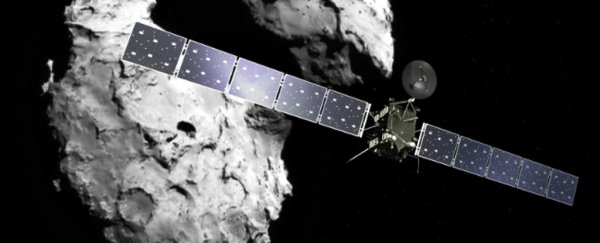The European Space Agency's (ESA) Rosetta spacecraft - you know, the probe that won our hearts back in 2014 when it entered the orbit of comet 67P/Churyumov-Gerasimenko, and dropped off the ill-fated Philae lander in the process - will cease operation on 30 September, officials have announced.
While the craft is still operational, it's quickly getting further and further away from the Sun, meaning that it will eventually run out of solar power, ceasing communication forever.
"The mission is coming to an end as a result of the spacecraft's ever-increasing distance from the Sun and Earth. It is heading out towards the orbit of Jupiter, resulting in significantly reduced solar power to operate the craft and its instruments, and a reduction in bandwidth available to downlink scientific data," ESA officials said.
Back in 2011, Rosetta survived the most faraway part of its mission so far, reaching a distance of 800 million kilometres (about 497 million miles) from the Sun, by entering a 31-month hibernation.
Now, it's orbiting nearby comet 67P/Churyumov-Gerasimenko, which reaches a max distance of over 850 million kilometres (528 million miles) from the Sun - far further away from the Solar System's centre than it's ever been.
Since the team doesn't believe Rosetta will be able to survive another prolonged hibernation at an even greater distance, they've decided that the craft will retire on the surface of the comet alongside Philae (in spirit, not actually next to each other).
"The final hours of descent will enable Rosetta to make many once-in-a-lifetime measurements, including very-high-resolution imaging, boosting Rosetta's science return with precious close-up data achievable only through such a unique conclusion," the team said. "Communications will cease, however, once the orbiter reaches the surface, and its operations will then end."
This process won't be easy, though. To land Rosetta on the comet, the team will have to meticulously maneuverer the craft as gravity shifts the closer it gets.
"The closer we get to the comet, the more influence its non-uniform gravity will have, requiring us to have more control on the trajectory, and therefore more manoeuvres - our planning cycles will have to be executed on much shorter timescales," said Rosetta's operations manager Sylvian Lodiot.
Even though the actual operation of Rosetta will soon come to an end, the team still has a tremendous amount of work ahead of them to analyse all the data collected by the craft. And there's no knowing what they'll find.
"We're trying to squeeze as many observations in as possible before we run out of solar power," said ESA project scientist Matt Taylor. "30 September will mark the end of spacecraft operations, but the beginning of the phase where the full focus of the teams will be on science. That is what the Rosetta mission was launched for and we have years of work ahead of us, thoroughly analysing its data."
There's something almost poetic about Rosetta joining Philae on the surface of 67P/Churyumov-Gerasimenko, especially considering how much emotional weight was placed on both of the projects.
Rosetta and Philae managed to capture the imaginations of space lovers across the world via Twitter - causing the two craft's to become widely anthropomorphised - which makes seeing them go all the harder.
The good news is that as one mission starts to fade away, others are just starting. In fact, NASA's Juno spacecraft will start beaming back data from Jupiter early next week, filling the spacecraft-sized void left by Philae and Rosetta.
Let's all just take a moment to remember how excited scientists were back in 2014 when Rosetta woke up from its hibernation.
We're not crying, you're crying.
 ESA
ESA
